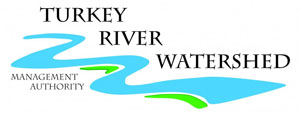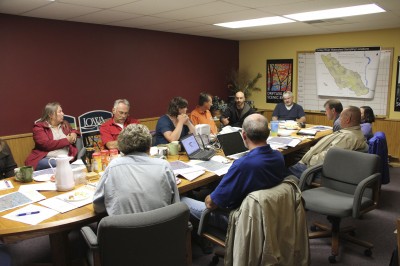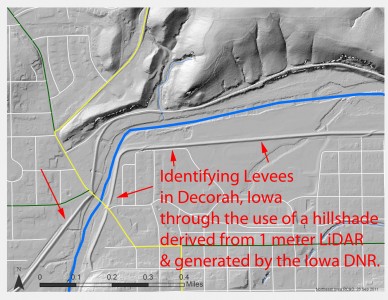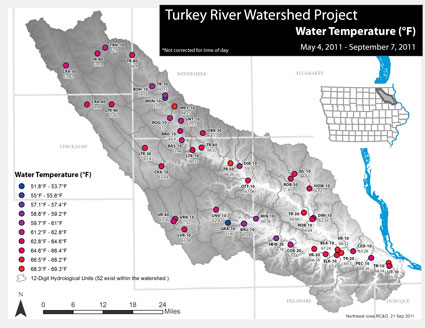Turkey River Watershed Alliance Meeting: September 2011
List of Participants
- Lee Bjerke, Winneshiek County Engineer
- Brad Crawford, Northeast Iowa RC&D
- Carrie Davis, Fayette County SWCD
- Laurel Foreman, NRCS Hydrologist
- Lora Friest, Northeast Iowa RC&D Director
- Chad Gilles, Howard County SWCD
- JD King, Fayette County Engineer
- Rod Marlatt, Fayette County Conservation
- Steve Manternach, NRCS Resource Conservationist
- Eric Palas, IDALS – DSC, Clayton County SWCD
- Michelle Schaefers, Fayette County SWCD District Conservationist
- Neil Shaffer, Howard County SWCD
- Lynette Seigley, Iowa DNR – IGSB
- Mary Skopec, Iowa Geologic Survey Bureau
- Jeff Tisl, IDALS – DSC, Regional Coordinator
Date: September 21, 2011, 8:30 a.m. – 12:00 p.m.
Location: Northeast Iowa RC&D, Postville, Iowa
Notes compiled by: Brad Crawford, [email protected], (563) 864-7112
Table of Contents
- Rapid Watershed Assessment
- Otter Creek Watershed Flood Mitigation Study
- Levees in the Turkey River Watershed
- Rainfall
- Surface Water Modeling
- Water Sampling Updates
- Watershed Management Authority (New)
Rapid Watershed Assessment
Steve Manternach, Resource Conservationist at NRCS reports good progress (pdf) on the Rapid Water Assessment, a well-thought-out document that will provide initial estimates of where conservation investments would best address the concerns of landowners, conservation districts, and other community organizations and stakeholders. It will be available online toward the end of 2012 and will include maps, GIS layers and tables, estimates of future conservation needs, modeling data, narratives, flood assessment and erosion estimates, and more. The Turkey River RWA is the first RWA in Iowa to use eRAMS, a new technology that will provides improved estimates of soil loss at the 12 Digit Hydrological Unit level. (There are fifty-two 12-Digit HUCs in the Turkey River Watershed.)
Document for review: Active and Complete Watershed Projects in the Turkey (add Lake Meyer)
Document for review: Top Environmental Quality Incentives Program (EQIP) Resource Concerns
Otter Creek Watershed Flood Mitigation Study
Laurel Foreman, Hydrologist at NRCS presented information on her hydrologic study of the Otter Creek watershed. The main stem of Otter Creek runs through both West Union and Elgin, and the study seeks to determine how flooding (within Otter Creek, but also within the Turkey River Watershed) may be reduced by the placement of water retention structures. Laurel’s analysis will show a future with nothing done structurally in the watershed, as well as a future with detention structures in the watersheds. The future with detention structures will show a reduction in flooding for the various frequency events (2 yr, 5 yr, 10 yr, 25 yr, 50 yr, 100 yr rainfall events).
The Otter Creek watershed was selected for study based on a number of factors, including watershed size (47.2 mi2), the presence of coldwater stream segments, an existing stream assessment conducted by Fayette County SWCD in 2006, and a history of flooding problems.
Inputs to the model, known as SITES include a runoff curve number of 74, the time of concentration (i.e., how long does it take for a drop of water at the top part of the watershed take to reach the mouth), drainage characteristics, and rainfall event frequency – determined from Technical Paper 40 (pdf). (Sidenote: new rainfall data from NOAA can be expected in 2013.) The output of running the SITES model (prior to placing any structures) was then be compared and to the USGS Regulation Equation, WIE (waiting of independent estimates), and the similarly sized Little Paint Creek watershed in Allamakee County (42.8 mi2).
Document: Otter Creek Watershed Peak Discharge Comparison
For this study, 55 possible water retention structures will be simulated in the watershed. These structures, each impacting between 50 to 600 acres, could cumulatively impact 18.2 mi2, or 38% of the Otter Creek watershed. Document: Study of Otter Creek Watershed – Retention Structures Map
City
A list of other watersheds within the Turkey River watershed that could benefit from a flood mitigation study, due to their size and features, was compiled:
- Brush Creek – Volga River (34.1 mi2)
- Bohemian Creek (28.0 mi2)
- Wonder Creek (20.2 mi2)
- Rogers Creek (20.2 mi2)
- Little Turkey River Headwaters (48.0 mi2)
- Turkey River-Chialk Creek (23.1 mi2)
- Howard Creek (31.1 mi2)
- Upper Roberts Creek (35.3 mi2)
Levees in the Turkey River Watershed
Studies are also being done to demonstrate the impact of levees within the watershed. The velocity of the water and the elevation that the water reaches are both impacted by levees. To assist in this modeling, an inventory of levees is being assembled.
- Elkport
- Elgin
- Fayette
- Elkader
- Fort Atkinson
- Spillville
- Several levees on private property in Fayette County
Download a shapefile of Potential Levees in the Turkey River Watershed (zip)
Surface Water Modeling in the Turkey River Watershed
Measurement of surface water flow is an important component of most water quality monitoring projects. Flooding, stream
geomorphology, and aquatic life support are all directly influenced by streamflow, and runoff and streamflow drive the generation, transport, and delivery of many nonpoint source pollutants. Calculation of pollutant loads requires knowledge of water flow. So while the Turkey River Watershed project is monitoring nonpoint source pollutants at 46 locations within the watershed, streamflow information is currently available for only four locations, the sites monitored by USGS streamflow gauges:
[stream_flow]
[stream_flow_volga]
| Site Name | Streamflow ft3/sec |
|---|
One tool to potentially assist in measuring surface water flow is modeling. The Karst topography in the Turkey River watershed may offer up a sizeable challenge to modeling, but Dan Christiansen, employed by the USGS in Iowa City, has had good luck modeling flow in the Upper Cedar River Basin using the PRMS model for example. (Past research: http://www.swcs.org/documents/resources/u_65_christiansen.pdf)
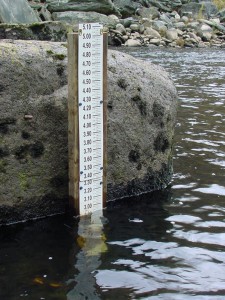
Other options for gathering streamflow data include the use of bridge sensors to electronically measure stream height, or placing staff gauges to manually measure stream height at the same time water quality samples are being collected.
Rainfall in the Turkey River Watershed
The Iowa Environmental Mesonet is a great tool that provides rainfall estimates across the state, but having additional local rainfall data would also be useful. The NRCS field offices in West Union, Elkader, and Cresco are each collecting precipitation data, and Brad will see to it that this data is added to the water quality/quantity data already being collected for the TRW.
Water Sampling Updates
- The seven organizations collecting water samples in the Turkey have completed 5 months of sampling at 46 sites, and will plan to add a November 2nd sampling date in addition to the October 5th date.
- Lynette contacted John Olson who conducts the 305b assessments for the DNR. With the 7 samples collected in 2011 and the 8 samples that will be collected in 2012 (April through November), John will have enough samples to do an assessment for all of the sites.
- USGS real-time nitrate sampling meter to be placed on Turkey River near Garber: (Current list of real-time nitrate monitoring sites in Iowa)
- A “State of the Turkey River Watershed” document to be developed for January/February 2012, with input from each of the partners.
- Lynette has offered to help the alliance develop our Quality Assurance Project Plan (QAPP) for the Turkey River Watershed Project
- Maps are now available which show average concentrations for each parameter that was monitored during the period May 2011 – September 2011
- Data for every sample taken as part of the Turkey River Watershed project is now available in a relational database, viewable at https://turkeyriver.org/water-sampling/.
* Additional maps located on the Maps/GIS-Analysis Page
Watershed Management Authority
Dear Partners,
Northeast Iowa RC&D has been asked to assist with the development of an application to the Iowa DNR to form a watershed management authority in the Turkey River Watershed.
The Iowa DNR and Iowa Department of Economic Development have jointly announced the availability of funding to form a watershed management authority but only six awards will be made within Iowa so it is important that we all work together to apply. A watershed management authority is an agreement between political subdivisions (cities, counties, and soil and water conservation districts) to foster cooperation, work together to address both water quality and water quantity issues, and ultimately to improve conditions in the watershed. Although one city or one county must be the lead applicant, letters of support from other political subdivisions in the watershed are needed to strengthen an application. That is where we need your help.
Clayton County Board of Supervisors passed a resolution on September 21st to be the lead applicant for the Turkey River Watershed Authority application. We now need letters of support from as many of you as possible.
Letters should be addressed to:
Iowa Department of Natural Resources
Wallace State Office Building
502 East 9th St, Des Moines, Iowa 50319
But please send your letter to us here at the RC&D so that we can compile them and send them in with the application.
Northeast Iowa RC&D
PO Box 916
Postville, Iowa 52162
Content for your letter of support should confirm you are supportive of the development of a Turkey River Watershed Authority. You can also note how your political subdivision (or representative) is currently participating in the Turkey River Watershed Project (i.e. water monitoring, attending meetings, financially contributing). You should also express your support for comprehensive, multi-objective planning that can take place through a Watershed Authority. If you have not previously participated in the Turkey River Watershed Project you can note how you believe the development of a Turkey River Watershed Authority will help the region add value to watershed management and encourage inclusivity among political subdivisions that might not otherwise participate in the Turkey River Watershed Project, including yourself. Your letter might also note the impact flooding has had on your community or jurisdiction, and how important it is to work together to reduce the severity of flood events.
Thank you,
Lora L. Friest
Executive Director
Northeast Iowa RC&D
PO Box 916
Postville, Iowa 52162
Phone: 563-864-7112
www.northeastiowarcd.org
Full RFP: http://www.iowadnr.gov/Portals/idnr/uploads/files/rfp/11oct_watershed.pdf
